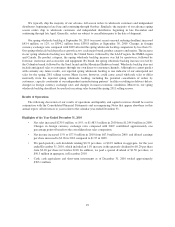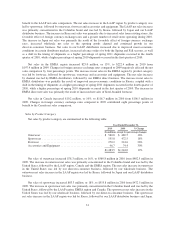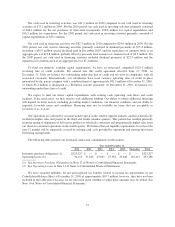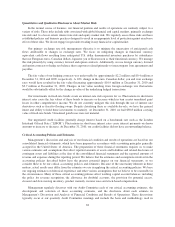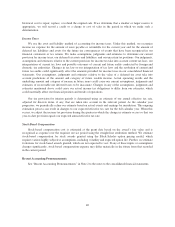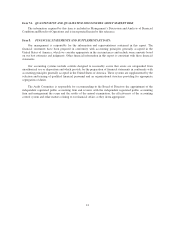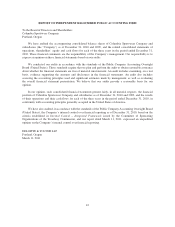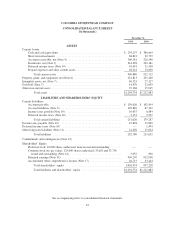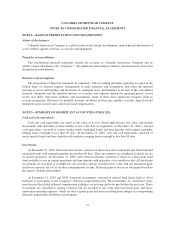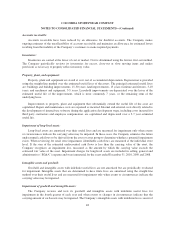Columbia Sportswear 2010 Annual Report Download - page 45
Download and view the complete annual report
Please find page 45 of the 2010 Columbia Sportswear annual report below. You can navigate through the pages in the report by either clicking on the pages listed below, or by using the keyword search tool below to find specific information within the annual report.developing and selecting these estimates, the trends in and amounts of these estimates, specific matters affecting
the amount of and changes in these estimates, and any other relevant matters related to these estimates, including
significant issues concerning accounting principles and financial statement presentation.
Revenue Recognition
We record wholesale, e-commerce and licensed product revenues when title passes and the risks and
rewards of ownership have passed to the customer. Title generally passes upon shipment to or upon receipt by the
customer depending on the terms of sale with the customer. Retail store revenues are recorded at the time of sale.
Where title passes upon receipt by the customer, predominantly in our Western European wholesale
business, precise information regarding the date of receipt by the customer is not readily available. In these cases,
we estimate the date of receipt by the customer based on historical and expected delivery times by geographic
location. We periodically test the accuracy of these estimates based on actual transactions. Delivery times vary
by geographic location, generally from one to six days. To date, we have found these estimates to be materially
accurate.
At the time of revenue recognition, we also provide for estimated sales returns and miscellaneous claims
from customers as reductions to revenues. The estimates are based on historical rates of product returns and
claims. However, actual returns and claims in any future period are inherently uncertain and thus may differ from
the estimates. If actual or expected future returns and claims are significantly greater or lower than the reserves
that we have established, we will record a reduction or increase to net revenues in the period in which we make
such a determination.
Allowance for Uncollectible Accounts Receivable
We make ongoing estimates of the uncollectibility of our accounts receivable and maintain an allowance for
estimated losses resulting from the inability of our customers to make required payments. In determining the
amount of the allowance, we consider our historical level of credit losses and we make judgments about the
creditworthiness of customers based on ongoing credit evaluations. We analyze specific customer accounts,
customer concentrations, credit insurance coverage, standby letters of credit, current economic trends, and
changes in customer payment terms. Continued uncertainty in credit and market conditions may slow our
collection efforts if customers experience difficulty accessing credit and paying their obligations, leading to
higher than normal accounts receivable and increased bad debt expense. Because we cannot predict future
changes in the financial stability of our customers, actual future losses from uncollectible accounts may differ
from our estimates and may have a material effect on our consolidated financial position, results of operations or
cash flows. If the financial condition of our customers deteriorates and results in their inability to make
payments, a larger allowance may be required. If we determine that a smaller or larger allowance is appropriate,
we will record a credit or a charge to SG&A expense in the period in which we make such a determination.
Inventory Obsolescence
We make ongoing estimates of potential future excess, close-out or slow moving inventory. We evaluate our
inventory on hand considering our purchase commitments, sales forecasts, and historical experience to identify
excess, close-out or slow moving inventory and make provisions as necessary to properly reflect inventory value
at the lower of cost or estimated market value. If we determine that a smaller or larger reserve is appropriate, we
will record a credit or a charge to cost of sales in the period in which we make such a determination.
Product Warranty
We make ongoing estimates of potential future product warranty costs. When we evaluate our reserve for
warranty costs, we consider our historical claim rates by season, product mix, current economic trends, and the
39


